Why tiny Jackson Hole, Wyo. in the international spotlight
Loading...
| JACKSON HOLE, Wyo.
Every August, the world's financial markets shift their attention from the centers of global commerce — New York, London, Tokyo — to a mountain valley in northwest Wyoming. On Friday, they will hear a speech by Federal Reserve Chairman Ben Bernanke.
So how did Jackson Hole, Wyo., come to wield such outsize importance in global economic affairs?
In a word, trout.
For four years starting in 1978, the Federal Reserve Bank of Kansas City hosted an annual conference at different sites and different times of year. The event drew little attention outside the insular world of economic analysts.
Inspired by a conference the Boston Fed held near a picturesque New Hampshire site where the tearjerker "On Golden Pond" was filmed, the Kansas City Fed held its 1981 conference in scenic Vail, Colo.
Still no luck. The Vail meeting drew the conference's smallest crowd ever.
Officials at the bank pondered how to draw bigger names and more attention to the yearly confab. That's when they set their sights on Paul Volcker, then chairman of the Federal Reserve in Washington.
They decided to pursue Volcker by dangling the prospect of one of his favorite pastimes: fly-fishing. They needed to find a sure-fire trout-catching spot somewhere in the Kansas City Fed district, which covers Colorado, Kansas, Nebraska, Oklahoma and Wyoming, as well as northern New Mexico and western Missouri.
They considered somewhere in Colorado. But a fly-fishing expert said Colorado's waters were too warm for trout in August. Go farther north, he said. Go to Jackson Hole.
"I'd never heard of it," confessed Tom Davis, then the Kansas City Fed's research director and point man on the project, according to the bank's official history of the event.
The shift was made. And what's been known since 1982 as the Jackson Hole Economic Symposium took its place in economic lore.
Jackson Hole isn't even a town. It's a valley. The biggest town, Jackson (population 9,710), lies at the southern end of Jackson Hole. Arches made of elk antlers mark the entrance to the town square. The Fed conference itself occurs farther north, in a lodge in Grand Teton National Park, about 50 miles south of Yellowstone National Park.
The event now draws 140 people every year, including some of the biggest names in economic and finance. They come to enjoy breathtaking views of the Grand Teton mountain range and Jackson Lake, to hike and fish and to engage in intellectual combat in the halls of the Jackson Lake Lodge.
One annual tradition is the Friday night barbecue. There, some of the world's most high-powered economists don cowboy hats, string ties and other Western gear and sometimes join in a line dance.
At each year's Jackson Hole conference, the Fed chairman is a focal point. The head of the European Central Bank normally is, too. (This year is an exception. The current ECB chief, Mario Draghi, who is fighting Europe's debt crisis, canceled plans to attend.)
In the final days of the Soviet Union in 1990, central bankers and economists from the former Eastern bloc came to Jackson Hole to learn how to manage post-Communist economies.
Not everything went well. The Soviet delegation had mistakenly checked the weather for steamy Jackson, Miss. The Soviet officials "almost froze" in Jackson Hole's brisk mountain air, recalled Roger Guffey, then Kansas City Fed president, according to the bank's history.
The proceedings can become contentious. At the first Jackson Hole conference, in fact, Volcker himself came under fire for his drive to shrink inflation by pushing up interest rates into double digits and allowing the U.S. economy to sink deep into recession.
A University of Chicago economist named Raghuram Rajan ruined the mood in 2005 at what was shaping up as a fawning farewell to the outgoing Fed chairman, Alan Greenspan. Rajan warned that the financial system had absorbed dangerous risks under Greenspan's watch.
Participants turned against Rajan. Former Treasury Secretary Lawrence Summers assailed him, calling his premise "misguided." Three years later, the world learned to its horror, as a meltdown of subprime mortgages started causing big banks to topple, that Rajan had been correct after all.
Investors started focusing especially intensely on Jackson Hole after Bernanke used his remarks there in 2010 to lay out the Fed's policy options. Among the options he mentioned was a second round of bond purchases, to pump cash into the financial system and juice the U.S. economy.
The speech — and growing evidence that the economy needed help — ignited a 28-percent stock market rally over the next eight months. (The Fed actually began the purchases — a policy known as quantitative easing, or QE2 — in November 2010.)
On Friday morning, attention will again be riveted on Bernanke's annual speech. Never mind that most analysts don't expect him to offer significant new guidance about what the Fed might do next. Many think Bernanke wants more time to survey the economic landscape.
For one thing, the speech comes just a week before Bernanke will get to review the government's report on August unemployment and two weeks before he'll meet with the rest of the Fed's policy committee.
His speech might not please some investors who continue to hold out hope that Bernanke will signal that further help from the Fed is on the way.
Jackson Hole is used to hype, though. Even before it became where the Fed spent its late summers, it inspired tall tales. In 1895, a front-page report in The New York Times wrongly reported that the community's entire population had been wiped out in an American Indian attack.
Later came reports of a 10-foot eagle —dubbed "Big Teton" — that carried off two antelopes in its talons.
Alas, the bird has not been spotted since.







